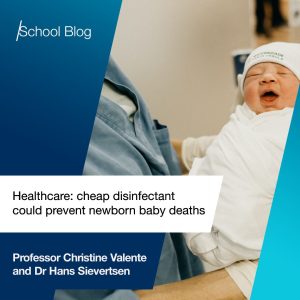 Community healthcare providers in low-income countries could save more babies’ lives by going beyond WHO guidance for sepsis prevention, Professor Christine Valente and Dr Hans Sievertsen’s research suggests.
Community healthcare providers in low-income countries could save more babies’ lives by going beyond WHO guidance for sepsis prevention, Professor Christine Valente and Dr Hans Sievertsen’s research suggests.
By Professor Christine Valente and Dr Hans Sievertsen
Healthcare policymakers and providers around the world are pouring more time and money than ever before into preventing newborn babies’ deaths. And their efforts are paying off: healthcare policies played a major part in bringing down the annual number of neonatal deaths from 4.6 million in 1990 to 2.6 million in 2015.
But the rate of progress is slowing and the figures nonetheless remain a tragedy.
Recent research by University of Bristol economists Christine Valente and Hans Sievertsen offers new insights for health policy and practice that could save even more babies from sepsis, one of the biggest causes of neonatal mortality.
A simple treatment to prevent neonatal sepsis
The study raises the question of whether WHO guidelines on preventing sepsis in newborns go far enough. Sepsis kills 400,000 babies within their first 28 days of life every year – or around 15% of all neonatal deaths. This blood infection is of particular concern in low-to-middle-income countries, where 99% of the world’s neonatal deaths occur.
In collaboration with Nepali demographer Mahesh Puri, Sievertsen and Valente evaluated the effects of chlorhexidine, a cheap and simple treatment that prevents sepsis in newborns.
Just one dab of this disinfectant gel applied to a baby’s umbilical cord stump on the day of birth helps stop infection from taking hold. A single dose costs as little as US$0.23. The overall cost of application, including overheads, is less than US$3.
Click here to read the complete article.
See more from Dr Hans Sievertsen and Christine Valente including their recent publications.
Discover more research from the School of Economics on our website.

